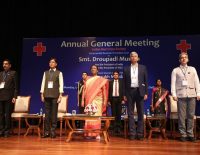How can Cancer prevention, control in India can get boost through primary health care‑based approach: Experts

India has a rising burden of cancer with an estimated 70% caused by modifiable and preventable risk factors. Cancers of the breast, cervix, and lip and oral cavity are the three most common malignancies, with distinct regional variations in India and account for 34% of the 1.15 million cancer cases diagnosed annually.
The major initiatives are focused initially on cancer treatment and prevention was added nearly a decade ago. Even with those, the scope and coverage of cancer prevention and treatment services has remained in hospitals and urban settings. India needs to build upon the ongoing approach which seems to be focused on “tracking the cancer, teaching the future and helping the masses” by implementing non‑vertical primary healthcare cancer prevention and control approach. Cancer prevention should be made an integral part of the health interventions, rapidly extended to primary healthcare services and facilities, linked with specialised treatment facilities, as India aims for universal health coverage. The opportunity provided by the Ayushman Bharat Programme launched in 2018 should be leveraged for rapid expansion and effective coverage of cancer prevention and treatment interventions in India.
Better understanding of cancer epidemiology for effective interventions
Things and possible approaches to cancer prevention and control seem to have been impacted by evolving learning and a better understanding of cancer epidemiology in India. It was documented that nearly 70% of the cancers in India are preventable; 40% of the preventable cancers are tobacco‑related, 20% are infection‑related, and 10% are due to other causes.
Alcohol has been recognised as the second leading risk factor in India, strongly associated with gastrointestinal cancers. The human papillomavirus (HPV) and hepatitis B virus, which cause cervical and liver cancer, respectively, have vaccines. Overall, around 20% of all cancers may be attributable to diet and related factors including obesity. Despite this, more than 80% of the people with cancer present to the facilities at advanced stages.
Treatment‑centric approach to cancer not enough
A treatment‑centric approach to cancer is not enough. A better understanding of cancer epidemiology encouraged several Indian states to consider a more holistic approach to cancer prevention and control as well as for rapid scale‑up of NPCDCS and cancer components. The need for a community component in cancer prevention was felt when it was realised that the key challenges in early diagnosis and treatment of cancer are related to the patients receiving wrong information, having poor knowledge, poor faith in public health services, and a weak cancer health infrastructure.
Tracking cancer, teaching the future and helping the masses
Establishing a well‑functioning health system which focuses on cancer prevention, screening, and early detection requires attention to three specific pillars which must be strengthened: Cancer registries, medical and health education, and community‑based screening and prevention interventions. Cancer control in India has made progress in the last four decades since the Indian Council of Medical Research launched the National Cancer Registry (NCR) Programme in 1981 to aggregate data from population‑based cancer registries (PBCR) and hospital‑based cancer registries (HBCR) from around India.
Primary health care could be the right platform for cancer prevention in India There is a strong case that cancer prevention requires a comprehensive approach which implements community interventions, strengthens PBCRs, and medical training. For example, opportunistic screening helps to detect cases but mostly at the terminal stages. Community screening and early detection help to diagnose cancer in the early stages but require a strong cancer health system for referral and affordable treatment. Successful cancer prevention strategies need to be attuned to the inter‑ and intra‑state variations of cancer burdens. This includes differences in the prevalence of cancer types as well as the total prevalence of cancers based upon differences in the position of the states within the epidemiological transition. Regardless of state variation, a substantial proportion of cancers are due to modifiable risk factors and can be targeted for prevention.
There is a need and benefit to focus on cancer prevention, and this should be done as part of a programme to comprehensively strengthen and integrate cancer prevention in the primary healthcare system in India. As the incidence of preventable cancers decreases in India, the incidence of less easily diagnosed cancers will increase which will require the current gaps in secondary and tertiary care to be filled. Prevention of cancer (along with other diseases), health promotion in general, delivered through the primary healthcare system, and strengthening of treatment services should be seen as a comprehensive intervention that will accelerate India’s journey towards universal health coverage. The opportunity provided by the ABP launched in 2018 should be leveraged for rapid expansion and effective coverage of cancer prevention and treatment interventions in India.
(Authors: Ayush Lohiya, Roy A. Daniel, Robert D. Smith, Mukesh Nagar, Abhishek Shankar, Chandrakant Lahariya)








Comments